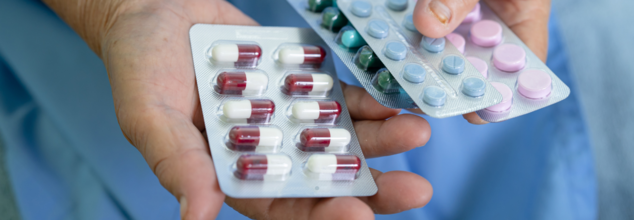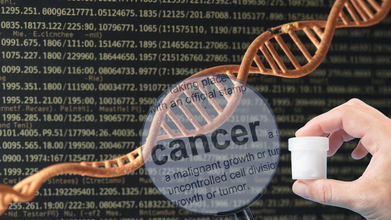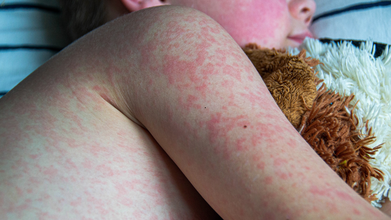- Health Conditions A-Z
- Health & Wellness
- Nutrition
- Fitness
- Health News
- Ayurveda
- Videos
- Medicine A-Z
- Parenting
FDA Greenlights Zevaskyn for Rare Genetic Skin Condition

Credits: Canva
In a landmark development for patients who live with a rare and painful skin condition, the US Food and Drug Administration or the FDA has approved Zevaskyn (prademagene zamikeracel) for the treatment of recessive dystrophic epidermolysis bullosa or RDEB. This is an inherited disorder that causes the skin to be extremely fragile. I also leads to chronic wounds, bleeding, and tearing even from minor friction or trauma.
As per the 2015 study published in the Journal of Clinical and Aesthetic Dermatology, there are four major subtypes of the skin disorder, which comes from the heterogeneous group of inherited mechanobullous disorder hat is caused by mutation in genes that encode structural proteins in the skin. The overall condition is referred to as epidermolysis bullosa, and one of its type is RDEB, which further comes with two main subtypes of dystrophic EB.
Zevaskyn is now the first and only autologous cell-based gene therapy approved for both adult and pediatric patients living with this life-altering condition.
Why Is This A Breakthrough In Gene Therapy?
Zevaskyn represents a new era in wound care and gene therapy. Unlike traditional treatments that only manage symptoms, this one-time surgical application targets the underlying genetic mutation responsible for RDEB. The therapy uses the patient's own skin cells, which are genetically modified to produce a functional version of the missing COL7A1 gene, critical for anchoring skin layers together.
"Zevaskyn is not just a bandage—it’s a breakthrough that may help change the course of this disease for many," said Madhav Vasanthavada, Ph.D., Chief Commercial Officer at Abeona Therapeutics, the biopharmaceutical company behind the treatment.
How Was It Approved?
The FDA based its approval from the results of two clinical trials: a phase 1/2a study and the pivotal phase 3 VITAL study.
Phase 1/2a Trial: In this study, seven patients with 38 chronic wounds received a single Zevaskyn application. Researchers observed a significant and long lasting improvement at treated sites during the median follow-up of seven years.
Phase 3 VITAL Study: This was a larger study that included 43 patients with large unhealed or non healing wounds. After six months, 81% of those wounds treated by Zevaskyn, showed at least 50% healing, as compared to only 16% in the control group, who had received the standard care.
These outcomes were not only statistically significant but also clinically meaningful, especially for patients who have previously struggled with limited treatment options.
Zevaskyn also showed a favorable safety profile across both studies. No treatment-related serious adverse events were reported. The most common minor side effects were procedural pain and itching, affecting approximately 5% of participants.
"This therapy offers hope for patients and families who have lived too long without effective solutions," said Vasanthavada. “We’re confident in Zevaskyn’s ability to deliver long-term results and are committed to making it widely accessible.”
Access For Patients
To ensure access, Abeona Therapeutics plans to collaborate with both commercial insurers and government payers. The company aims to develop outcome-based agreements that reflect the long-term benefits of a single application of Zevaskyn, reducing the need for repeat procedures or ongoing wound care costs.
With FDA approval, Zevaskyn is set to be a game-changer in the treatment of recessive dystrophic epidermolysis bullosa—offering patients more than just relief, but a meaningful step toward healing.
Oral Weight Loss Pill Comes Next Year, Says Eli Lily As It Announces A Third Manufacturing Facility In US

Credits: Canva
Eli Lily's CEO David Ricks announced a new US factory worth over $6 Billion as per several reports that will manufacture the awaited weight loss pill: Orforglipron. The company had earlier announced that the weight loss pill had successfully met the “primary and all key secondary endpoints” in a large clinical trial, paving the way for global regulatory submissions.
“With these positive data in hand, we are moving with urgency toward global regulatory submissions to potentially meet the needs of patients who are waiting,” said Kenneth Custer, Eli Lilly’s executive vice president and president of cardiometabolic health.
“If approved, we are ready to offer a convenient, once-daily pill that can be scaled globally, removing barriers and redefining how obesity is treated around the world.”
This comes after President Donald Trump on its website TrumpRx allowed Americans to purchase prescription medication from pharmaceutical companies at discounted rates, among them also include GLP-1 medications. The Trump administration also unveiled agreements with Eli Lily to make these drugs more affordable. Trump has taken a special interest in the 'fat drug'.
In an exclusive interview with CNN's Erin Burnett, CEO Ricks shared that this new weight loss pill will be coming out next year. Eli Lily is also the company that has made Zepbound. Talking about the side effects of weight loss drugs, which included weight loss drugs reducing age, or people reporting pancreas problems, or the drugs changing brain's make up to curb down cravings, the CEO said that these were just a selected few people reporting such results. He said that he has received emails, photos from before and after of people who have been on weight loss drugs and how they are with their transition. "There were people who were changing not just the way they look, but also their health status in this country and around the world. So most of the evidence is from the opposite side," he said.
In terms of life expectancy, he said that "most of the data that we have collected it [weight loss drugs] extends life". How? "They do it through preventing diabetes, preventing heart attacks, and preventing other serious anomalies that comes through obesity," said the CEO.
What Is Orforglipron?
Originally discovered by Japan’s Chugai Pharmaceutical and later licensed to Eli Lilly in 2018, orforglipron is now in Phase 3 trials. The company is testing it not just for weight management and type 2 diabetes but also for conditions linked to obesity, including obstructive sleep apnea and hypertension.
Why An Oral Option Matters
Injectable GLP-1 receptor agonists like semaglutide and tirzepatide have already transformed obesity and diabetes care, but accessibility remains a hurdle. For many patients, injections are intimidating, inconvenient, or simply not practical in daily life.
That’s where an oral pill could be a game-changer. A once-daily tablet could remove psychological and logistical barriers, making it easier for patients to stay on treatment. And given the rising global burden of obesity, which significantly raises the risk of cardiovascular disease, stroke, and some cancers, the demand for more convenient treatment options has never been greater.
Pills vs. Injections: Which Works Better?
The big question now is whether oral GLP-1 drugs are as effective as their injectable counterparts.
A 2021 research review published in Springer Nature, offers some clues. After examining multiple studies, researchers concluded that oral semaglutide, a similar class of drug, provided “similar or better efficacy and similar tolerability” compared to injectable GLP-1 receptor agonists.
Also Read: How To Identify A Counterfeit Ozempic? Look For These Signs
In some cases, oral versions were found to be just as effective for weight loss and lowering A1C levels in people with type 2 diabetes. However, the review focused on patients already using insulin, which may have influenced outcomes. Experts emphasize that while results are encouraging, more research is still needed to directly compare oral and injectable versions in broader populations.
Sperm Donor With Cancer Causing Gene Fathered Almost 200 Children Across Europe

Credits: Canva
An unknowing harboring of genetic mutation that raised the risk of cancer by a sperm donor who fathered at least 197 children across Europe. BBC reported on a major investigation that revealed that some children have already died and only "a minority who inherit the mutation will escape cancer in their lifetimes".
According to BBC, the sperm was not sold to UK clinics, in fact, a "very small" number of British family used the sperm while they had their fertility treatment in Denmark. It was the European Sperm Bank of Denmark that admitted that the sperm was used to make too many babies in some countries and that they had their "deepest sympathy" for the families affected.
What Was The Investigation All About?
The investigation was conducted by 14 public broadcasters, which included BBC, as part of the European Broadcasting Union's Investigative Journalism Network.
This is what the investigation revealed: This sperm donor, who was perfectly healthy on paper started donated sperm as a young student in 2005. He was paid for each donation. He passed all the routine screening tests and showed no signs of illness. For nearly 17 years, women across Europe used his sperm to have children.
But there was something inside his DNA that no one could have detected at the time.
Before the donor himself was born, a random change occurred in some of the cells that were forming his body. This mutation damaged a crucial gene called TP53. This gene acts like the body’s security guard. Its job is to spot dangerous changes in cells and stop them from turning cancerous.
Most of the donor’s body does not carry this mutation, which is why he has never become ill. However, his sperm cells are a different story. Up to 20% of them carry the faulty TP53 gene.
This created a devastating possibility. If a sperm carrying the mutation fertilizes an egg, the resulting child will have the mutation in every single cell of their body. That child is then born with Li Fraumeni syndrome, a condition that brings an up to 90 percent lifetime risk of cancer. These cancers often appear in childhood and include leukemia, bone cancers, brain tumors and breast cancer later in life.
The donor had no idea any of this was happening. Neither did the clinics using his sperm.
How Was This Mutation Discovered?
The alarm was first raised when doctors across Europe began seeing children with aggressive cancers whose genetic tests all pointed back to the same TP53 mutation. Eventually, they discovered that the children were conceived using sperm from the same donor.
By the time this was uncovered, the donor’s sperm had been used by 67 fertility clinics across 14 countries. At least 197 children are known to have been born using his donations, though the final number could be higher. It is not yet known how many of them inherited the dangerous gene.
Doctors say several of these children have already been diagnosed with cancer, some have developed more than one cancer, and some have died.
Dr Edwige Kasper, a cancer geneticist in France, has been helping families navigate the diagnosis.
“We have many children who have already developed cancer,” she said. “Some have had two cancers and some died very early.”
A Mother’s Discovery
One mother, whose name is changed to Céline (as per the BBC report), conceived her daughter with the donor’s sperm in Belgium. 14 years later, she received a call from the clinic urging her to get her child screened.
Her daughter tested positive for the mutation.
Céline says she does not blame the donor but is devastated that she was given sperm that “was not safe”. She knows cancer could strike at any point.
“We do not know when, we do not know which cancer, and we do not know how many times,” she said. “When it comes, we fight.”
How Regulation Failed
There is no global law limiting how many families a sperm donor can help. Each country sets its own rules.
In Belgium, for example, one donor should be used for no more than six families. This donor helped create 38 families in Belgium alone.
The UK limit is ten families, but the donor’s sperm was never sold directly to UK clinics. Instead, the Danish authorities informed the UK that a small number of British women travelled to Denmark for treatment using this donor’s sperm. Those women have since been contacted.
The European Sperm Bank admits national limits were breached in some countries and says the donor was immediately blocked once the mutation came to light. They say the donor and his relatives are healthy and that this type of mutation cannot be detected with standard screening.
Can Donor Screening Ever Catch Everything?
Experts say cases like this are extremely rare but nearly impossible to prevent entirely.
“You cannot screen for everything,” said Prof Allan Pacey from the University of Manchester. “If we make screening even tighter, we would not have any donors left.”
He added that countries have become too dependent on large international sperm banks, which supply multiple nations simultaneously.
Important Questions Parents Must Ask
Experts advise choosing licensed clinics and asking:
- Is the donor local or from another country?
- How many families has this donor helped?
- What screening has been done?
Measles Outbreak: South Carolina and Utah Report New Cases as School and Community Exposures Grow

Credits: Canva
Measles Outbreak: It is not yet over in the US, two states, South Carolina and Utah are dealing with ongoing measles outbreaks and have reported more infections today along with additional school and community exposure. South Carolina confirmed 27 new cases, bringing its total to 114. Utah reported 10 more cases, raising its statewide count to 115.
What Is Happening In These Two States?
In South Carolina, health officials said all 27 new cases are from Spartanburg County, which remains the center of the Upstate outbreak. Of the state’s 114 cases, 111 have been recorded in this county alone. The outbreak has been connected to exposures at two elementary schools earlier in the season.
The newly confirmed infections stem from a mix of exposure settings. According to the South Carolina Department of Public Health, sixteen of the new patients were linked to an earlier exposure at the Way of Truth Church in Inman. Eight were household contacts of known cases. One patient was connected to a previously identified school exposure and another picked up the infection in a health care setting. The source of exposure for one case remains unclear.
Health officials said 254 people are currently in quarantine and 16 are in isolation. Among those quarantined are 43 students from Inman Intermediate School. Most of the state’s patients are children and teenagers. Seventy-five cases fall in the five to seventeen age group. Vaccination rates remain a major concern. Officials confirmed that 105 of the infected individuals are unvaccinated. Three others had received one dose of the vaccine, one was fully vaccinated, and two have an uncertain immunization history.
In Utah, the state has recorded 10 new measles cases in the past week. The most recent patient was infectious while attending the Kopper Kids child care program inside Bingham High School in South Jordan, located in Salt Lake County. Authorities said the individual was unvaccinated, though they have not disclosed whether the patient is a child or an adult.
“Measles is extremely contagious, so quick action is critical,” said Dorothy Adams, executive director of the Salt Lake County Health Department. She added that because the source of this infection is unknown, families and staff linked to Bingham High School should watch closely for symptoms and remain aware of possible exposure.
Salt Lake County has reported only three measles cases this year. Most of Utah’s cases, a total of 82, have occurred in the Southwest Utah health district near the Arizona border.
What Is Measles?
Measles, a highly contagious viral disease, had been largely controlled in the U.S. thanks to the widespread use of the measles, mumps, and rubella (MMR) vaccine. However, gaps in vaccination coverage have led to a resurgence.
The disease is known for its rapid transmission. A single case can lead to significant spread if vaccination rates in a community fall below the 95% threshold needed for herd immunity. Children are particularly vulnerable; although the first dose of the MMR vaccine is typically administered at 12 months, increased parental concern has led some to seek earlier vaccination during the outbreak.
Early warning signs include:
- Fever
- Fatigue and tiredness
- Cough and runny nose
- Red, inflamed eyes
© 2024 Bennett, Coleman & Company Limited

